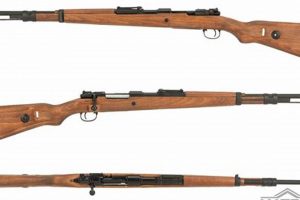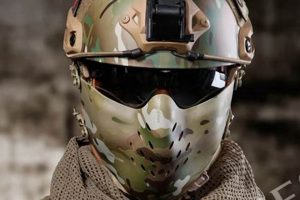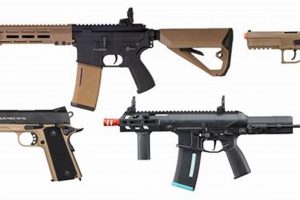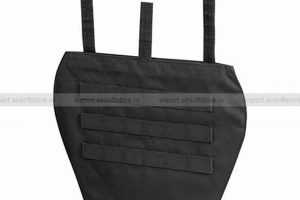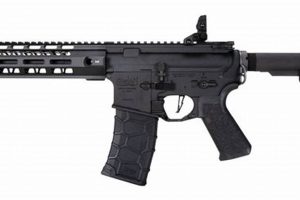The subject refers to replicas of a World War II-era German general-purpose machine gun, modified for use in simulated combat scenarios. These replicas typically fire plastic pellets propelled by compressed gas or electric power, differing significantly from the firearm they imitate. An example would be a battery-powered replica used in organized skirmishes, replicating the appearance and, to a degree, the function of the historical weapon.
These simulated weapons offer enthusiasts a way to experience historical aesthetics and tactical gameplay without the dangers associated with live firearms. The appeal often stems from an interest in military history, combined with the competitive and social aspects of the sport. Replicas contribute to a greater level of realism in scenarios, enhancing participant immersion.
The following sections will delve into specific aspects of these replicas, including their construction, operational mechanics, maintenance considerations, and suitability for various playing styles. Further discussion will cover legal restrictions and safety precautions associated with their use.
Tips for Optimizing the Replicated MG42
This section provides guidance on enhancing the performance and longevity of the airsoft replica of the historical MG42 platform. The focus is on maintenance, modification, and tactical deployment for optimal effectiveness in simulated combat scenarios.
Tip 1: Regular Maintenance is Critical: Disassembly and cleaning after each use prevents jams and ensures consistent performance. Pay particular attention to the barrel and hop-up unit, as pellet residue accumulation impacts accuracy.
Tip 2: Battery Selection Impacts Rate of Fire: Utilize a battery with sufficient voltage and amperage output to achieve the desired rate of fire. A higher voltage may increase the rate, but it also risks damaging the motor. Research compatibility specifications.
Tip 3: Hop-Up Adjustment for Range and Accuracy: The hop-up unit applies backspin to pellets, increasing range and counteracting gravity. Proper adjustment is crucial. Experiment with small increments until the trajectory is flat and consistent.
Tip 4: Utilize a Bipod for Stability: The authentic MG42 was designed for sustained fire from a stable platform. Using the integrated or an aftermarket bipod minimizes muzzle climb and improves accuracy during prolonged engagements.
Tip 5: Upgrade Internal Components for Enhanced Performance: Consider upgrading the motor, gears, and air seal components for improved rate of fire, power, and reliability. Research reputable brands and compatibility with the specific replica model.
Tip 6: Secure Ammunition Feed for Reliability: Ensure the ammunition box is properly secured and feeds smoothly into the replica. Jams can be common due to misaligned or damaged feeding mechanisms.
Tip 7: Practice Safe Handling Procedures: Treat the replica with the same respect as a real firearm. Always keep the muzzle pointed in a safe direction and ensure the safety is engaged when not actively firing.
Adhering to these tips will not only enhance the operational effectiveness of the replicated MG42 but also prolong its lifespan and ensure user safety. Consistent maintenance and strategic upgrades are paramount.
The following sections will provide information about safety and legal considerations.
1. Historical Accuracy
Historical accuracy plays a significant role in the appeal and value of the MG42 airsoft replica. It dictates the extent to which the replica mirrors the appearance, dimensions, and operational characteristics of the original firearm, influencing both aesthetic satisfaction and the realism of simulated combat scenarios.
- External Detailing and Markings
The precision of external detailing, including the replication of sights, grips, and the overall shape of the receiver, directly affects the visual fidelity. Authentic markings, such as Waffenamt stamps and manufacturer codes, further enhance the realism. Discrepancies in these details can detract from the historical authenticity.
- Material Composition and Finish
The materials used in construction contribute significantly to the perceived realism. Replicas employing metal components and accurately mimicking the finish of the original firearm’s bluing or parkerization offer a more convincing representation. Polymer or plastic substitutes, while potentially more cost-effective, may compromise historical accuracy.
- Dimensions and Weight
Accurate scaling and weight distribution are crucial for replicating the handling characteristics of the original MG42. A replica that deviates significantly in size or weight will feel less authentic and may affect the player’s ability to simulate historical tactics effectively.
- Functional Replication
Beyond mere aesthetics, functional replication of certain features, such as the bipod deployment, charging handle operation, and magazine feeding mechanisms, enhances the immersive experience. While complete replication of the firearm’s internal mechanics is not feasible, accurately mimicking key functional aspects adds to the overall realism.
These facets of historical accuracy significantly influence the desirability of the MG42 airsoft replica for collectors and participants in historical reenactments. Replicas with greater attention to detail command higher prices and contribute to a more immersive and authentic simulation experience.
2. Replication Materials
The selection of replication materials for replicas directly impacts its durability, realism, and cost. The materials used determine the replica’s weight, finish, and ability to withstand the rigors of simulated combat.
- Metal Composition
Metal components, such as steel and aluminum alloys, are frequently employed in the construction of critical parts like the receiver, barrel, and bipod. The use of metal enhances the replica’s robustness and provides a more authentic weight and feel. However, metal construction increases the overall cost.
- Polymer Alternatives
High-strength polymers, such as ABS plastic and nylon-reinforced composites, offer a cost-effective alternative to metal. These materials provide adequate durability for many applications while significantly reducing the replica’s weight. Polymer components are commonly used for the stock, pistol grip, and other non-critical parts.
- Wood Imitation
Some replicas feature wood or wood-imitation components to enhance the visual authenticity. Real wood stocks and grips provide a premium feel, but are susceptible to damage from moisture and impact. Wood-imitation polymers offer a more durable and weather-resistant alternative.
- Internal Component Materials
The materials used in internal components, such as gears, pistons, and hop-up units, directly affect the replica’s performance and longevity. High-quality steel gears and reinforced pistons are essential for withstanding the stresses of repeated firing. Precise tolerances and durable materials in the hop-up unit are crucial for accuracy.
The combination of replication materials in determines its overall performance characteristics. The balance between durability, realism, and cost is a crucial consideration in the design and manufacturing of these replicas.
3. Firing Mechanism
The firing mechanism is integral to the functionality of any , dictating how compressed gas or electricity propels projectiles. Understanding these mechanisms provides insights into performance, maintenance, and potential modifications.
- Electric (AEG) Systems
Automatic Electric Guns (AEGs) utilize a battery-powered motor to drive a gearbox, which in turn compresses a spring. When released, the spring forces a piston forward, creating an air pulse that propels the pellet. AEGs offer a consistent rate of fire and are commonly used for sustained gameplay. The AEG system allows for modifications to the rate of fire via battery or gear changes.
- Gas Blowback (GBB) Systems
Gas Blowback (GBB) systems employ compressed gas, typically CO2 or green gas, to propel the pellet and cycle the action. After each shot, the slide or bolt moves rearward, mimicking the operation of a real firearm. GBB systems offer a more realistic feel and recoil, but can be sensitive to temperature changes and require regular maintenance.
- High-Pressure Air (HPA) Systems
High-Pressure Air (HPA) systems utilize an external compressed air tank connected to the replica via a hose. A regulator controls the pressure delivered to the firing mechanism, providing consistent power and accuracy. HPA systems offer a wide range of adjustable parameters and are often favored for long-range engagements. HPA systems are capable of extreme rates of fire and custom tuning.
- Hybrid Systems
Hybrid systems combine elements of different firing mechanisms to achieve specific performance characteristics. For example, an may use a gas blowback system for realistic recoil while utilizing an electric motor to power the magazine feeding mechanism. Hybrid systems offer a blend of realism and practicality but can be more complex to maintain.
The selection of the appropriate firing mechanism for depends on the desired level of realism, performance requirements, and maintenance preferences. Each system offers distinct advantages and disadvantages, influencing the overall user experience.
4. Rate of Fire
The rate of fire, measured in rounds per minute (RPM), is a critical performance characteristic, intimately linked to its historical counterpart. The authentic MG42 was renowned for its exceptionally high rate of fire, a feature replicated to varying degrees in its versions. This characteristic significantly impacts its role in simulated combat scenarios, influencing tactical deployment and effectiveness. A higher RPM allows for increased suppressive fire, potentially overwhelming opposing forces. However, it also necessitates more frequent magazine changes and can deplete power sources (batteries or gas) more rapidly.
The rate of fire in replica variants is determined by several factors, including the motor’s speed in electric-powered models, the gas pressure and valve design in gas-powered versions, and the overall mechanical design. Replicas often feature adjustable rate of fire settings, allowing users to tailor the performance to specific game rules or tactical situations. For example, some fields may impose limitations on the maximum RPM to promote fair play or conserve ammunition. High ROF builds also put extra stress on internal components.
Understanding the interplay between rate of fire and other performance characteristics is crucial for maximizing the effectiveness of these replicas. While a high RPM may seem desirable, it must be balanced against factors such as accuracy, range, and ammunition capacity. Successfully managing this balance enhances the user’s ability to employ the platform effectively in a variety of simulated combat engagements. The impact of ROF also requires users to consider upgrades or modifications to internal components.
5. Weight Distribution
Weight distribution is a critical aspect of the replica, influencing handling characteristics, maneuverability, and overall user experience. The MG42, in its original form, was a substantial firearm, and replicating its weight distribution accurately is crucial for realistic simulation.
- Front-Heavy Configuration
The authentic MG42 possessed a noticeable front-heavy bias due to the long barrel, bipod, and heavy receiver. Replicas often attempt to emulate this weight distribution to enhance realism. However, an excessively front-heavy replica can become cumbersome during prolonged use, negatively impacting maneuverability in dynamic gameplay scenarios.
- Material Selection Influence
The choice of materials significantly affects weight distribution. Utilizing metal components in the receiver, barrel assembly, and bipod replicates the heft of the original firearm, contributing to a more authentic feel. Conversely, employing lighter polymer materials can shift the weight balance, making the replica easier to handle but potentially sacrificing realism.
- Impact on Stability
Proper weight distribution contributes to stability during firing. A well-balanced replica is less prone to muzzle climb, allowing for more accurate sustained fire. The bipod, typically mounted near the front of the , also plays a crucial role in stabilizing the platform, particularly in prone or supported firing positions.
- Ergonomic Considerations
Weight distribution influences ergonomic design. A replica with a balanced weight distribution is more comfortable to carry and operate, reducing user fatigue. The placement of the pistol grip and stock, in relation to the center of gravity, directly affects handling and control during simulated combat engagements.
The interplay between these facets of weight distribution is pivotal in determining the overall usability and realism of the . Replicas that successfully balance historical accuracy with ergonomic considerations provide a more satisfying and immersive experience for users.
6. External Modifications
External modifications for replicas encompass a range of accessories and alterations designed to enhance their appearance, functionality, or tactical utility. These modifications allow users to personalize their replicas, adapt them to specific gameplay styles, or increase their realism.
- Optical Sighting Systems
The addition of optical sighting systems, such as red dot sights or magnified scopes, improves target acquisition and accuracy. These systems are typically mounted on the receiver or a custom rail system. The choice of optic depends on the intended range of engagement and the user’s preferences. Historical replicas can also feature reproduction iron sights or scopes.
- Bipods and Tripods
Enhanced stability is achieved through the use of bipods or tripods. These accessories reduce muzzle climb and improve accuracy during sustained fire. The original MG42 featured a bipod, and replicating this feature contributes to a more authentic experience. Aftermarket bipods may offer adjustable height or improved stability.
- Ammunition Carriers and Pouches
To facilitate the sustained rate of fire, ammunition carriers and pouches are employed to store and transport spare magazines or ammunition boxes. These accessories are typically attached to the user’s gear or the replica itself. Historical reenactments often require accurate reproductions of wartime ammunition carrying equipment.
- External Detailing and Customization
Users often add external detailing, such as weathering, paint schemes, or replica markings, to enhance the visual realism. These modifications can range from simple paint jobs to complex weathering techniques that simulate wear and tear. Custom engravings or historically accurate markings can further enhance the replica’s authenticity.
The cumulative effect of external modifications extends beyond mere aesthetics, influencing the replica’s overall performance and tactical role. By selecting modifications strategically, users can tailor their replicas to excel in specific gameplay scenarios or achieve a higher degree of historical accuracy.
Frequently Asked Questions
This section addresses common inquiries regarding replicas of the MG42, focusing on performance, safety, and legal considerations for prospective users.
Question 1: What is the typical effective range?
The effective range varies depending on the model, power source, and hop-up configuration. Typically, engagements occur within 150-200 feet, though accuracy diminishes beyond this range.
Question 2: What safety precautions must be observed?
Eye protection is mandatory. Mesh or full-seal goggles are recommended. Additionally, replicas should be treated as real firearms, with the muzzle pointed in a safe direction at all times.
Question 3: What type of ammunition is compatible?
These replicas typically use 6mm plastic pellets, with weights ranging from 0.20g to 0.28g. The optimal weight depends on the replica’s power and hop-up configuration.
Question 4: What maintenance is required?
Regular cleaning of the barrel and hop-up unit is essential for maintaining accuracy and preventing jams. Periodic lubrication of internal components is also recommended.
Question 5: Are there legal restrictions on ownership or use?
Local laws governing the ownership and use of replicas vary. It is the user’s responsibility to comply with all applicable regulations, including restrictions on carrying replicas in public.
Question 6: What is the difference between AEG and GBB models?
AEG (Automatic Electric Gun) models are powered by batteries and offer a consistent rate of fire. GBB (Gas Blowback) models use compressed gas to propel the pellets and simulate recoil, providing a more realistic experience.
These answers provide a foundational understanding of replicas. Further research and adherence to safety guidelines are crucial for responsible use.
The following section will detail the future trends for “mg42 airsoft”.
Conclusion
The exploration of replicas reveals a nuanced landscape where historical accuracy, performance, and safety converge. The preceding sections have detailed the multifaceted aspects of these replicas, from their construction and operational mechanics to considerations of legality and responsible use. The intent has been to provide a comprehensive understanding for those interested in these simulated weapons.
Continued engagement with this subject demands a commitment to informed decision-making and ethical conduct. As technology evolves, so too will the capabilities and realism of airsoft replicas. Therefore, users must remain diligent in adhering to safety protocols and legal regulations. This dedication ensures the continued enjoyment and responsible practice of this simulated combat activity.


